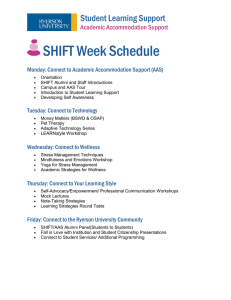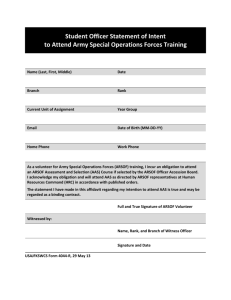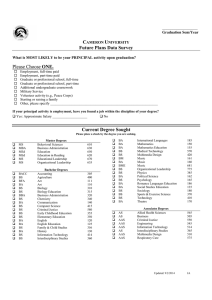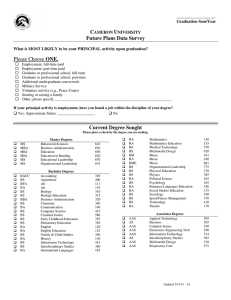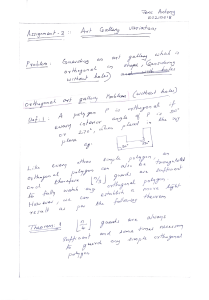Social Media & Steroid Abuse in Adolescents: Connections & Solutions
advertisement
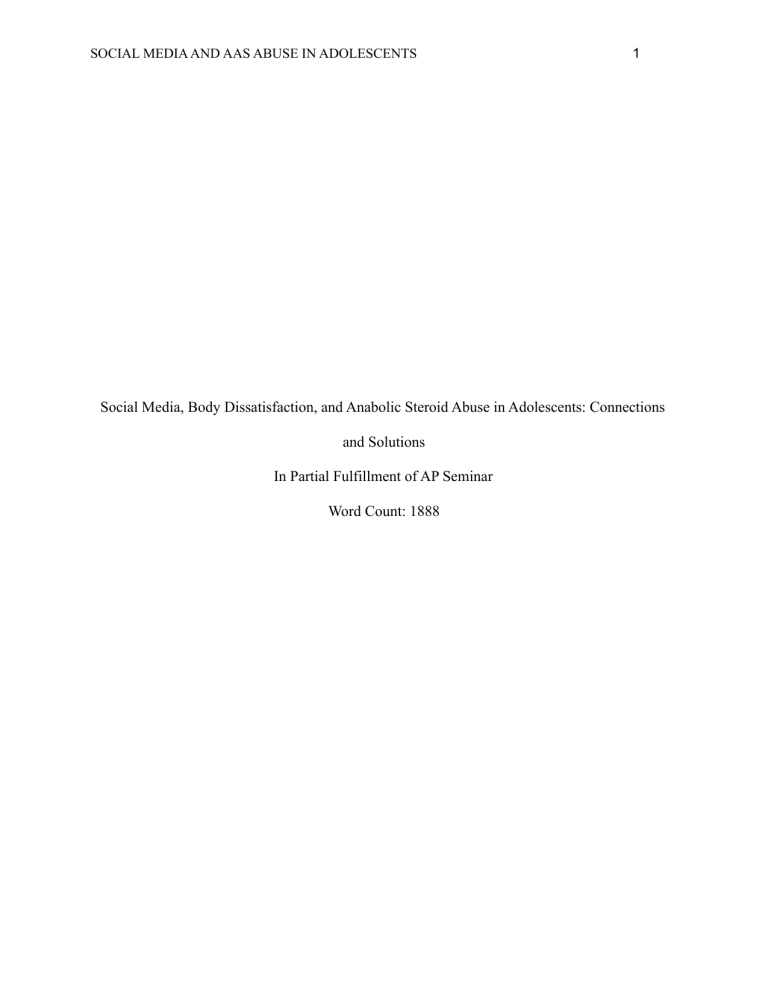
SOCIAL MEDIA AND AAS ABUSE IN ADOLESCENTS 1 Social Media, Body Dissatisfaction, and Anabolic Steroid Abuse in Adolescents: Connections and Solutions In Partial Fulfillment of AP Seminar Word Count: 1888 SOCIAL MEDIA AND AAS ABUSE IN ADOLESCENTS 2 In previous years, the rise of social media and its accompanying mental health risks have led to many unforeseen impacts. One of the most important of these was the negative self-image many develop after spending excessive time on these platforms. Image-centric platforms such as Facebook and Instagram have had the largest contribution to this issue, leading to obsession with outward appearance and idealized perceptions. As stated by Rachel Monroe (2021), “The more we began documenting our own lives for public consumption, meanwhile, the more we became aware of ourselves…” (pp. 6). This includes many aspects of how people present themselves, but can also be linked back to various unhealthy practices intended to help adolescents reach the beauty standards set by social media. One such practice rising in prevalence amongst adolescents is anabolic-androgenic steroid (or AAS) abuse. The category of AAS includes testosterone, its synthetic derivatives, and selective androgen receptor modulators (SARMS), all of which have the goal of increasing muscle mass and strength. The use of these substances is intended to improve athletic performance and body image but ultimately has many irreversible side effects, especially in adolescents. Given this alarming prevalence of anabolic steroid use in adolescents, what methods would be most effective in limiting both AAS access and use causes to prevent their negative physiological effects on this developing age group? Given the current research surrounding the topic the implementation of practical educational programs is the most efficient and effective solution. While many of the dangers surrounding the use of AAS are well researched, this knowledge does not currently appear to deter their use amongst adolescents. While this knowledge is available, those considering the use of AAS do not seem to readily seek education on the topic. This was explained by Sam Wright (2009), a research associate at Manchester SOCIAL MEDIA AND AAS ABUSE IN ADOLESCENTS 3 Metropolitan University, in his statement, “There is a large degree of mistrust among steroid users towards medical warnings about the possible consequences of using steroids” (p. 93). This shows that information against the use of AAS simply being available has not been enough to deter their use. Often users will obtain information on the safety of the drug from peers and other inaccurate sources rather than those with real data on their potential physiological impacts. A study by Stale Pallesen (2006), a professor of psychology at the University of Bergen, found, “that a large proportion of adolescents have access to models that have used or use anabolic steroids” (p. 1712). Oftentimes these models are the source of AAS acquisition and knowledge regarding the subject. This leaves many adolescents with a lack of genuine knowledge surrounding the risk factors of AAS. While it has been demonstrated adolescents oftentimes lack proper education on the dangers of AAS, it is still vital to determine the causes of AAS use. While AAS use is often thought of in regard to performance enhancement amongst competitive athletes, the majority of the time this is not the case. Oftentimes, according to Willem de Ronde (2020), a researcher at Amsterdam University Medical Center, the majority of AAS abuse is non-competitive and internally motivated. This means an increase in internal factors which predict steroid use such as low body image or self-esteem is an important angle to study while combating AAS use. By understanding these factors the motivations for abusing AAS can be limited, therefore lowering the population of adolescents who feel inclined to use them. One such factor that contributes to steroid use, poor body image, has been found to be increasing in recent years. According to Himanshu et. al. (2020), a researcher in medicine and psychology, “social media influence and increasing screen time seems to be a factor in declining body image” and “growing body dysmorphia especially among adolescent age group is a cause of concern” (p. 2). With these two SOCIAL MEDIA AND AAS ABUSE IN ADOLESCENTS 4 findings, it can be understood social media has been impacting the body image of adolescents, thus leading to AAS abuse as an easy method to reach the idealized body standards they see on these platforms. This was further backed by Scott Griffiths et al. (2018), a researcher at the University of Texas, who stated “there was a pattern of small-sized positive relationships of social media and dating app use with body dissatisfaction, eating disorder symptoms, and thoughts about using anabolic steroids” (p. 5). The links found in these studies between the use of social media and thoughts about the use of anabolic steroids show there is more to the issue than simply discouraging their use for a competitive advantage. For instance, drug tests in school athletic programs would be unable to catch, and therefore help, students who are not taking part in formal athletic programs. Only by tackling the underlying issues of self-esteem and providing scientifically backed information on the dangers of AAS use can adolescents be soundly convinced to avoid these harmful substances. In order to meet these requirements, the best solution for AAS abuse in adolescents is the widespread implementation of the ATLAS program or similar counterparts. According to Mary M. Mulcahey et al. (2010), a doctor of biochemistry, “The program consisted of ten 45-minute interactive classroom sessions and 3 exercise sessions regarding sports nutrition, exercise alternatives, effects of substance abuse in sports, drug refusal role-playing, and creation of health promotion messages” (p. 110). The comprehensive nature of the program allows it to cover many aspects of athletic training, nutrition, body composition, and the relation of AAS to these topics. This allows not only for education on the dangers of AAS but also the setting of realistic standards and goals for growth in muscle and performance. A study by Linn Goldberg et al. (1996), a professor of medicine at Oregon Health & Science University, found that “Under both analysis models, players exposed to the intervention were more likely than control players to SOCIAL MEDIA AND AAS ABUSE IN ADOLESCENTS 5 increase their belief that they had a ‘good’ body” (p. 718). By setting achievable expectations and making adolescents aware they are being exposed to unrealistic goals their body image can be improved and their odds of using AAS decrease. Even further than this the program provides scientifically backed information on the dangers of AAS use, which has proven effective in dispelling the distrust of medical warnings surrounding these drugs. In addition, the program is one of the most cost-effective solutions to the issue. In one implementation of the program, equipment costed only $3000, making it possible to implement across schools with little adaptation in budgeting. With the capability of the program to reduce steroid use established, the benefits of reducing AAS use in adolescents must be made clear. The foremost reason for such an intervention would be the many health risks that accompany the use of AAS. Thiago Gagliano-Jucá and Shehzad Basaria (2019), researchers on men’s aging, health, and metabolism, stated that there were negative impacts on the health of the musculoskeletal, cardiovascular, reproductive, dermatologic, and neuropsychiatric systems. These impacts are only further exacerbated by the continual development of adolescents. Hormone balances that are impacted by AAS use cause even more harm to adolescents who use these products. For instance, according to Robert C. Hickson et. al. (1989), a physical education researcher at the University of Illinois, “It is well documented that anabolic steroids exert negative actions on circulating testosterone levels in both patients and athletes” (p. 261). Testosterone is an essential hormone in developing adolescents which connects to both bodily and cognitive development. Adverse impacts on testosterone’s natural production after using steroids therefore will have even more profound danger for developing adolescents. In a study on these connections Tuong-Vi Nguyen et al. (2012), an assistant professor in developmental neuroimaging, stated, “findings were SOCIAL MEDIA AND AAS ABUSE IN ADOLESCENTS 6 compatible with the view that testosterone influences brain development, that this influence changes with age and sex, and further suggested sex-related hemispheric lateralization effects of testosterone” (p. 1430). These vital developments are greatly influenced by the loss of natural testosterone production caused by AAS use. Furthermore, lowering AAS prevalence in this age group would create a cyclical effect in which a lack of unrealistic comparisons further removes incentives to abuse steroids. According to Luuk Hilkens et al. (2021), an exercise physiologist, some “[p]ossible explanations why social media may cause body dissatisfaction include the continuous physical appearance comparisons with idealized images of models and peers” (p. 2). As the number of peers using AAS decreases the likelihood of use decreases with it, creating an effect in which the number of people on AAS continually decreases. It is also important to recognize that this effect works the other way, making the immediate implementation of these programs necessary to stop the increasing rates of AAS abuse. Despite the appeal of these programs, however, many still believe them to be ineffective compared to simply eliminating the supply of AAS to adolescents. The belief these programs are not taken seriously and that adolescents set on steroid use will ignore their message is prevalent. One study in support of this was conducted by Kathy T. Do et. al. (2020), who found that “[p]articipants had above-chance rates… of resisting than conforming to conflicting attitudes” (p. 27). This shows that adolescents are likely to resist conflicting attitudes, which, if they are in a risk group for steroid abuse, includes the messages of the ATLAS program. This would inevitably lead to the conclusion that limiting the supply of steroids so they are impossible for adolescents to obtain would be the best solution to the AAS epidemic. While this at first sounds appealing, further research shows that it is largely impossible to implement. Steroids are often obtained through unprofessional third-party sources such as the internet, friends, and other illegal SOCIAL MEDIA AND AAS ABUSE IN ADOLESCENTS 7 means. J. Abram McBride et. al. (2016), a physician at Urological Associates, found “the demand for designer AAS to avoid legal detection ensures the continued growth of the AAS market, particularly on the Internet” (p. 4). The predominant presence of the AAS market on both the internet and in illegal dealing means eliminating supply would be an almost impossible undertaking. Additionally, it would be far more expensive than implementing educational programs. These two factors point to the use of the ATLAS program on a wider scale as the most effective method for quelling the AAS epidemic. From the previously shown evidence, it can be seen that AAS use among adolescents is a growing and important issue. The negative health and growth impacts of AAS on this age group combined with their high susceptibility to risk factors for its use have led to a growing population of those afflicted. In order to prevent this, the ATLAS program is the most cost-effective and viable method. It has been proven to reduce misconceptions surrounding steroids and reduce the likelihood of their use. Additionally, it would be reasonably cheap compared to alternative solutions such as attempts to destroy the supply of AAS to adolescents. Going forward both sides of this issue must be better understood to reverse the ongoing damage of this epidemic. Not only must education on steroids themselves be emphasized, but the poor self-image which most often results in their use must be examined as well. Additionally, image-centric social media platforms responsible for adolescents’ unrealistic expectations must be addressed. If we do not take these steps, an increasing number of children will become reliant on these harmful substances, creating a culture of unhealthy competition that ends with no winners. SOCIAL MEDIA AND AAS ABUSE IN ADOLESCENTS 8 Reference Page de Ronde, W., & Smit, D. L. (2020). Anabolic androgenic steroid abuse in young males. Endocrine Connections, 9(4). https://doi.org/10.1530/ec-19-0557 Do, K.T., McCormick, E.M., Telzer, E.H. (2020, August 11). Neural sensitivity to conflicting attitudes supports greater conformity toward positive over negative influence in early adolescence. Elsevier Science & Technology Journals. Gagliano-Jucá, T., & Basaria, S. (2019). Abuse of anabolic steroids: A dangerous indulgence. Current Opinion in Endocrine and Metabolic Research, 9, 96–101. https://doi.org/10.1016/j.coemr.2019.10.002 Goldberg, L., Elliot, D. L., Clark, G. N., Mackinnon, D. P., Zoref, L., Moe, E., Green, C., & Wolf, S. L. (1996). Effects of a multidimensional anabolic steroid prevention intervention. JAMA, 276(19), 1555. https://doi.org/10.1001/jama.1996.03540190027025 Griffiths, S., Murray, S. B., Krug, I., & McLean, S. A. (2018). The contribution of social media to body dissatisfaction, eating disorder symptoms, and anabolic steroid use among sexual minority men. Cyberpsychology, Behavior, and Social Networking, 21(3), 149–156. https://doi.org/10.1089/cyber.2017.0375 Hickson, R. C., Ball, K. L., & Falduto, M. T. (1989). Adverse effects of anabolic steroids. Medical Toxicology and Adverse Drug Experience, 4(4), 254–271. https://doi.org/10.1007/bf03259912 Hilkens, L., Cruyff, M., Woertman, L., Benjamins, J., & Evers, C. (2021). Social media, Body Image and resistance training: Creating the perfect ‘me’ with dietary supplements, anabolic steroids and Sarm’s. Sports Medicine - Open, 7(1), 1–13. https://doi.org/10.1186/s40798-021-00371-1 McBride, J. A., Carson, C. C., & Coward, R. M. (2016). The availability and acquisition of illicit anabolic androgenic steroids and testosterone preparations on the internet. American Journal of Men's Health, 12(5), 1352–1357. https://doi.org/10.1177/1557988316648704 Monroe, R. (2021, March). Ultra-fast fashion is eating the world. The Atlantic. The Atlantic Monthly Group. Mulcahey, M. K., Schiller, J. R., & Hulstyn, M. J. (2015). Anabolic steroid use in adolescents: Identification of those at risk and strategies for prevention. The Physician and Sportsmedicine, 38(3), 105–113. https://doi.org/10.3810/psm.2010.10.1815 Nguyen, T.-V., McCracken, J., Ducharme, S., Botteron, K. N., Mahabir, M., Johnson, W., Israel, M., Evans, A. C., & Karama, S. (2012). Testosterone-related cortical maturation across childhood and adolescence. Cerebral Cortex, 23(6), 1424–1432. https://doi.org/10.1093/cercor/bhs125 Pallesen, S., Jøsendal, O., Johnsen, B.-H., Larsen, S., & Molde, H. (2006). Anabolic steroid use SOCIAL MEDIA AND AAS ABUSE IN ADOLESCENTS 9 in high school students. Substance Use & Misuse, 41(13), 1705–1717. https://doi.org/10.1080/10826080601006367 Singla, G., Himanshu, Kaur, A., & Kaur, A. (2020). Rising dysmorphia among adolescents : A cause for concern. Journal of Family Medicine and Primary Care, 9(2), 567. https://doi.org/10.4103/jfmpc.jfmpc_738_19 Wright, Sarah Grogan, Geoff Hunter, S. (2001). Body-builders' attitudes towards steroid use. Drugs: Education, Prevention and Policy, 8(1), 91–95. https://doi.org/10.1080/09687630124157
